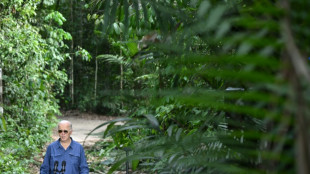
-
 Star Australian broadcaster charged with sex offences
Star Australian broadcaster charged with sex offences
-
Philippines cleans up after sixth major storm in weeks

-
 Woman-owned cafe in Indonesia's Sharia stronghold shakes stigma
Woman-owned cafe in Indonesia's Sharia stronghold shakes stigma
-
Indigenous Australian lawmaker who heckled King Charles censured

-
 End of an era as Nadal aims for winning Davis Cup farewell
End of an era as Nadal aims for winning Davis Cup farewell
-
Trump taps big tech critic Carr to lead US communications agency

-
 Mitchell-less Cavs rip Hornets as perfect NBA start hits 15-0
Mitchell-less Cavs rip Hornets as perfect NBA start hits 15-0
-
Markets swing after Wall St losses as traders weigh US rates outlook

-
 India's capital shuts schools because of smog
India's capital shuts schools because of smog
-
Rio under high security for G20 summit

-
 G20 leaders to grapple with climate, taxes, Trump comeback
G20 leaders to grapple with climate, taxes, Trump comeback
-
Hopes set on G20 spurring deadlocked UN climate talks

-
 Gabon early results show voters back new constitution
Gabon early results show voters back new constitution
-
Child abuse police arrest star Australian broadcaster

-
 Disgraced Singapore oil tycoon to be sentenced for fraud
Disgraced Singapore oil tycoon to be sentenced for fraud
-
Stray dogs in Giza become tourist draw after 'pyramid puppy' sensation

-
 UN Security Council to weigh call for immediate Sudan ceasefire
UN Security Council to weigh call for immediate Sudan ceasefire
-
Is AI's meteoric rise beginning to slow?

-
 Israeli strikes on Beirut kill six, including Hezbollah official
Israeli strikes on Beirut kill six, including Hezbollah official
-
Rain wipes out England's final T20 in West Indies

-
 US speaker opposes calls to release ethics report on Trump's AG pick
US speaker opposes calls to release ethics report on Trump's AG pick
-
McDonald's feast undercuts Trump health pledge

-
 Thousands march through Athens to mark student uprising
Thousands march through Athens to mark student uprising
-
NBA fines Hornets' Ball, T-Wolves' Edwards, Bucks coach Rivers

-
 China's Xi says to 'enhance' ties with Brazil as arrives for G20: state media
China's Xi says to 'enhance' ties with Brazil as arrives for G20: state media
-
Bills snap nine-game Chiefs win streak to spoil perfect NFL start

-
 Biden answers missile pleas from Ukraine as clock ticks down
Biden answers missile pleas from Ukraine as clock ticks down
-
Senegal ruling party claims 'large victory' in elections

-
 Dutch plan 'nice adios' for Nadal at Davis Cup retirement party
Dutch plan 'nice adios' for Nadal at Davis Cup retirement party
-
Trump meets PGA boss and Saudi PIF head amid deal talks: report

-
 UN chief urges G20 'leadership' on stalled climate talks
UN chief urges G20 'leadership' on stalled climate talks
-
Steelers edge Ravens, Lions maul Jaguars

-
 No.1 Korda wins LPGA Annika for seventh title of the season
No.1 Korda wins LPGA Annika for seventh title of the season
-
Biden touts climate legacy in landmark Amazon visit

-
 England secure Nations League promotion, France beat Italy
England secure Nations League promotion, France beat Italy
-
Star power fails to perk up France's premiere wine auction

-
 Rabiot brace fires France past Italy and top of Nations League group
Rabiot brace fires France past Italy and top of Nations League group
-
Carsley relieved to sign off with Nations League promotion for England

-
 Sinner says room to improve in 2025 after home ATP Finals triumph
Sinner says room to improve in 2025 after home ATP Finals triumph
-
Senegal counts votes as new leaders eye parliamentary win

-
 Biden clears Ukraine for long-range missile strikes inside Russia
Biden clears Ukraine for long-range missile strikes inside Russia
-
Lebanon says second Israeli strike on central Beirut kills two

-
 Puerto Rico's Campos wins first PGA title at Bermuda
Puerto Rico's Campos wins first PGA title at Bermuda
-
Harwood-Bellis risks wedding wrath from Keane after England goal

-
 'Nobody can reverse' US progress on clean energy: Biden
'Nobody can reverse' US progress on clean energy: Biden
-
NBA issues fines to Hornets guard Ball, T-Wolves guard Anthony

-
 Biden allows Ukraine to strike Russia with long-range missiles: US official
Biden allows Ukraine to strike Russia with long-range missiles: US official
-
Britain dump out holders Canada to reach BJK Cup semi-finals

-
 Biden clears Ukraine for missile strikes inside Russia
Biden clears Ukraine for missile strikes inside Russia
-
Ukrainians brave arduous journeys to Russian-occupied homeland


Fungi and flatworms: Scientists want more diverse nature emojis
Too many cats, not enough crustaceans: The current emoji catalog doesn't accurately represent the breadth of biodiversity seen in nature -- and that hurts conservation efforts, according to scientists.
An analysis published Monday in the journal iScience found that while animals are well represented by the current emoji catalog, plants, fungi, and microorganisms get short shrift.
"While the biodiversity crisis may seem distant from the online world, in our increasingly digitized society, we should not underestimate the potential of emojis to raise awareness and foster appreciation for the diversity of life on Earth," wrote authors Stefano Mammola, Mattia Falaschi, and Gentile Francesco Ficetola.
"The development and maintenance of diverse and inclusive emoji sets are crucial to ensure the equitable representation of the tree of life in digital communication tools," added the University of Milan conservation biologists.
The team assessed emojis related to nature and animals available in Emojipedia, a curated online catalog of emojis, and tracked how these changed between 2015 and 2022.
Among animals, vertebrates -- including mammals, birds, reptiles, amphibians, and bony fish -- were overrepresented, making up 76 percent of animal emojis.
Arthropods, including insects, arachnids, crustaceans, were proportionally underrepresented, despite there being 1.3 million described species of arthropod compared to 85,000 known species of vertebrate.
The researchers also noted there were no emojis representing either platyhelminths -- flatworms, including tapeworms -- or nematodes, despite there being more than 20,000 platyhelminth species and almost 20,000 nematode species.
On the flip side, they found emoji biodiversity was increasing. "Annelids gained representation in 2020 with the addition of the 'worm' emoji, which most likely represents an earthworm, and cnidarians gained representation in 2021 with the addition of a red coral emoji," they found.
W.Stewart--AT


